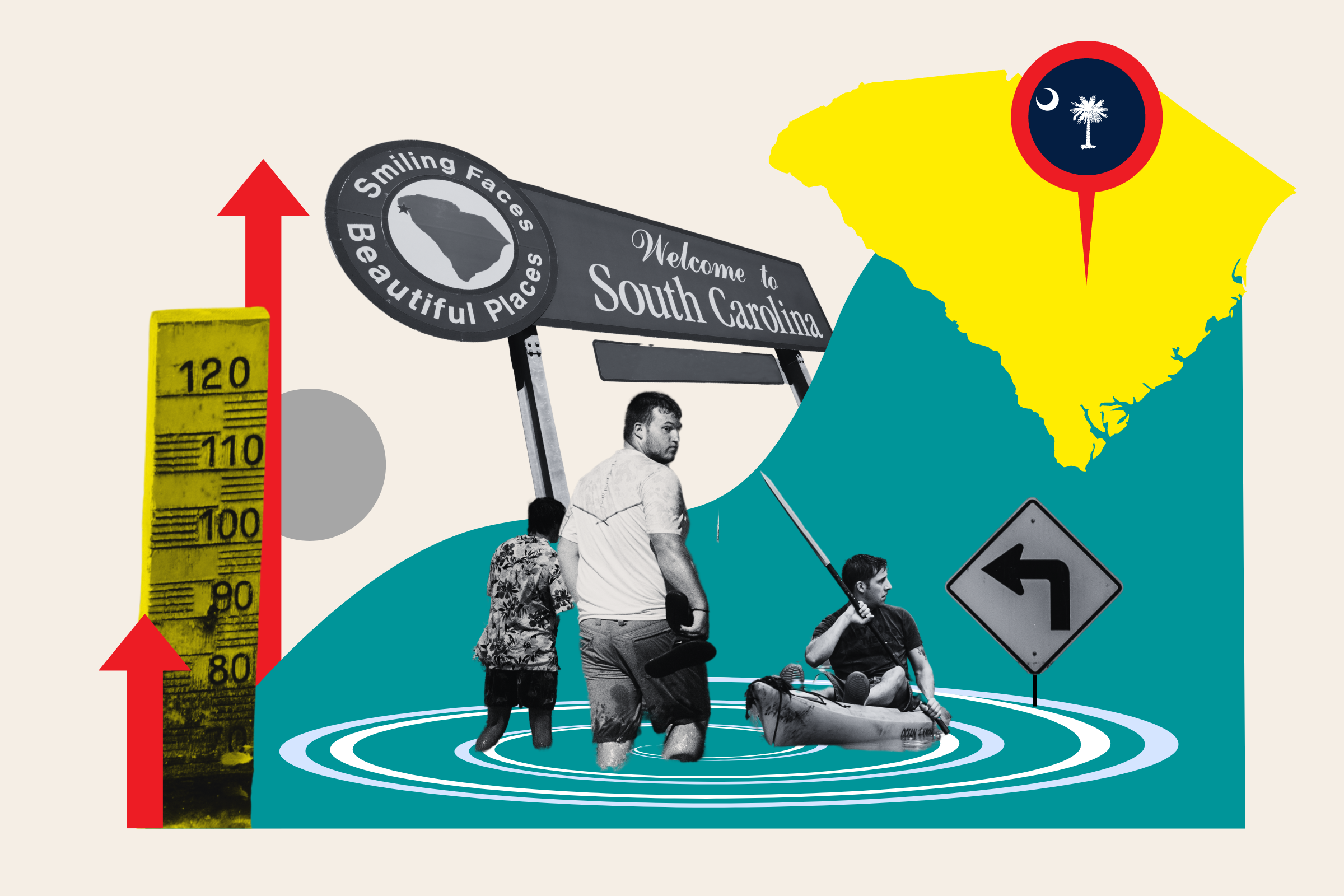Rhode Island
Major hurricane season predicted; insurers aren’t taking chances • Rhode Island Current

Unless a ton of climate and weather scientists are wrong, the U.S. could be in for the worst Atlantic hurricane season ever.
“This season is looking to be an extraordinary one,” said Rick Spinrad, administrator of the National Oceanic and Atmospheric Administration, Thursday morning at a briefing to announce NOAA’s predictions for the upcoming hurricane season, which starts on June 1 and runs through Nov. 30.
NOAA is predicting an 85% chance of an above-normal season, with 17 to 25 named storms, eight to 13 hurricanes and four to seven major hurricanes, which are those that have sustained winds of at least 111 mph — categories 3, 4 and 5.
“The forecast for named storms, hurricanes and major hurricanes is the highest NOAA has ever issued for the May outlook,” Spinrad said.
The forecast is in keeping with several earlier forecasts, including one issued by Colorado State University. Nearly two months ago, CSU predicted a very active season with 23 named storms, 11 to become hurricanes and five major hurricanes. It was the highest prediction for hurricanes that CSU has ever issued in its April outlook, which began in 1995.
Climate change is part of the culprit. It has caused unprecedented warmth in the oceans, which means there is more fuel for storms. Matthew Rosencrans, NOAA’s lead hurricane forecaster, said sea surface temperatures in the main storm development area are where they would normally be in August — that’s 2 to 3.5 Fahrenheit degrees above normal for this time of year. Another factor is the cyclical weather pattern known as La Niña, which is expected in late summer. It is conducive to more active hurricane seasons because its low wind shear conditions allow storms to stay intact. Forecasters are also seeing active African monsoons. The warm water just makes everything worse.
“It’s really the confluence of factors,” Rosencrans said.
It could be not a single storm hits land anywhere, nevermind this part of the Atlantic basin. But as the longstanding mantra goes, repeated multiple times during NOAA’s announcement: it only takes one. Witness 1992, predicted to be a very mild hurricane year. And indeed that was the case, with fewer than a handful of hurricanes. But one of them was Andrew. To this day it remains among the worst hurricanes to strike the U.S., devastating south Florida and parts of the Gulf coast.

As many in Connecticut’s shoreline communities have already discovered, or may discover soon, insurance companies are not taking chances. Homeowners insurance rates are increasing — by double digits year-over-year, in some cases. And what’s known as a “hurricane deductible,” once a rarity, is now close to ubiquitous.
To be clear, some of this is a result of the continuing COVID legacy of inflation and supply chain difficulties. Replacement costs for homes are just higher than they used to be. But a great deal, if not most of it, is a function of the massive payouts insurance companies have faced from natural disasters that are more frequent and extreme, courtesy of climate change. In the west, it’s wildfires. On the East and Gulf Coasts, it’s storms.
Understanding what an insurance company does or doesn’t cover, what Connecticut allows or requires it to cover, and the minefields that may be all over insurance policies can be nothing short impenetrable.
Here’s what to know:
Homeowners insurance is not flood insurance
If wind from a hurricane or any other kind of storm blows pieces of your house off or dumps a tree on your roof causing damage, homeowners insurance should cover it (at least after the deductible).
If rain from that same storm or hurricane floods and wrecks your ground floor, homeowners insurance will not cover it. You’d need flood insurance, which is required in many, but not all, cases.
On the other hand, if the tree that lands on your roof makes a big hole and rain comes pouring through the hole, that should be covered by homeowners insurance.
How a hurricane deductible works
Insurance policies typically have a deductible, which is the amount you have to pay off the top before insurance starts paying. It is typically a flat amount of money.
A hurricane deductible is the same in that it’s the amount you have to pay off the top, but it’s different in that the amount is a percentage of the value of the structure. So if your homeowners policy values your home at $500,000, a 5% hurricane deductible means you would have to pay $25,000 out of pocket before insurance would cover anything. A 2% deductible would mean you’d have to pay $10,000.
To be clear, the deductible is based on the value of the dwelling, not on the cost of the repair. If a hurricane wrecks your roof and the cost of repair is $20,000 and your deductible is $25,000, you’re going to have to pay for the whole thing.
The benefit of a hurricane deductible is that the overall cost of the insurance policy stays lower.
Hurricane deductibles can be used only in parts of Connecticut
Insurance is regulated by states, so the rules in Connecticut most likely will not be the same everywhere.
Hurricane deductibles are only allowed in coastal area communities — the 24 that border Long Island Sound, plus another nine that are close: North Branford, Orange, Essex, Deep River, Chester, Killingworth, North Stonington, Ledyard and Lyme.
For homes within 2,600 feet of the shoreline as the crow flies — that’s just about a half-mile — companies may impose a hurricane deductible up to 5%. Beyond that distance within those communities, they can only go up to 2%. In each case, they can go to a lower percentage but not a higher one.
In some policy renewal cases for homes more than 2,600 feet from the coast, the use of already-existing storm shutters or other mitigation such as impact-resistant glass can nullify a hurricane deductible requirement.
When can a hurricane deductible be activated?
In Connecticut, insurance companies may activate a hurricane deductible only if, during the time the National Hurricane Center has a hurricane warning in place anywhere in the state, through 24 hours after that warning is removed or downgraded, there is a sustained wind of more than 74 miles per hour anywhere in the state. (As defined by NOAA, sustained wind is an average of wind speed at a given location over a two-minute period.)
That statute was put in place after the confusion around Tropical Storm Irene in 2011 and Storm Sandy in 2012. Both storms had been downgraded by the time they reached Connecticut. The last storm to score a direct hit on Connecticut as a hurricane was Gloria in 1985.
Since it was clarified, the updated hurricane deductible policy has never been triggered.
Wind/hail deductibles
This is another product insurance companies are using in storm-prone areas to help them recoup losses. Like hurricane deductibles, they can help lower the cost of an insurance policy. But they do not need a trigger the way a hurricane deductible does. Nor are they capped at certain percentages.
“If you have a wind/hail deductible on your policy, it can be applied at any time; you don’t need a hurricane,” said George Bradner, assistant deputy commissioner and director of the property and casualty division at the Connecticut Insurance Department. “It’s important for consumers to understand that if they accept a wind/hail deductible in lieu of a hurricane deductible, anytime the wind blows, they could have that deductible apply.”
In the end, wind/hail deductibles could wind up costing homeowners more, given the prevalence of extreme storms in recent years. They are allowed in all parts of the state, but they cannot be mandated by insurance companies.

Gray areas remain
Take a storm like Sandy, which occurred in 2012. Scientifically, it was considered a post-tropical cyclone at the time it made landfall in New Jersey, even though it had maximum sustained winds that were hurricane force (80 mph). Therefore, the National Weather Service could not issue a hurricane warning. There was much debate afterward over whether that classification caused residents of New Jersey in particular to not take the storm as seriously as they should have. Sustained winds from Sandy did not meet hurricane criteria in Connecticut.
The National Hurricane Center, in an email response to how Sandy would be handled now, said: “The change made after Sandy is that the NWS can issue and maintain hurricane/tropical storm/storm surge watches and warnings for systems that are expected to transition from a tropical cyclone to a post-tropical cyclone near land.” For internal purposes, such a storm would still be considered a post-tropical cyclone. “But we can use watches and warnings to communicate wind and storm surge risks despite the classification.”
What would that mean for a hurricane deductible trigger? We don’t know.
“Each situation is going to have to be looked at and reviewed by the department,” Bradner said. “We’ll look at the statute, we’ll meet with our lawyers and with the commissioner and we’ll make a determination if a deductible can or cannot apply.”
NOAA also unveiled a new version of its well-known cone that shows on a map where a hurricane is likely to go. The new version, which is experimental for the upcoming season, will show more broadly where impacts from a hurricane might reach beyond the standard cone, and what those impacts might be. What might that eventually mean for a hurricane deductible trigger? We don’t know that either.
Minefields
Getting the correct information, knowing the terminology, checking the rules and being aware of what’s in an insurance policy can be among the most challenging parts of the process.
If your company has a hurricane deductible in place, it has to state that and the dollar amount prominently on your policy. But check if your company is considered “admitted” or not. Most of the roughly 140 insurance companies operating in the state are “admitted,” making them subject to insurance department regulations. The department has limited authority over non-admitted companies.
A company can’t refuse to renew someone or cancel them solely because they’ve had a catastrophe claim. A company can’t just decide to stop writing new policies.
However, companies can refuse to insure someone who’s had multiple claims. For people who can’t get homeowners insurance through the normal market and must have it — mainly people who have mortgages — the state has a bare-bones insurance program of last resort called the FAIR (Fair Access to Insurance Requirements) Plan. Within it there is a plan called the Coastal Market Assistance Program, or C-MAP, for coastal homeowners who have been unable to get insurance.
Some people who aren’t required to have insurance are simply going without.
“Which is insane,” said Eric George, president of the Insurance Association of Connecticut, an industry and lobbying group. “There are people who own their homes outright who do not have coverage. That’s where people are really rolling the dice, but a lot of people are doing that on the coastline because it’s just it’s too expensive.”
A company cannot mandate use of storm shutters or high-impact glass but can offer premium discounts for them.

When can a hurricane deductible be activated?
In Connecticut, insurance companies may activate a hurricane deductible only if, during the time the National Hurricane Center has a hurricane warning in place anywhere in the state, through 24 hours after that warning is removed or downgraded, there is a sustained wind of more than 74 miles per hour anywhere in the state. (As defined by NOAA, sustained wind is an average of wind speed at a given location over a two-minute period.)
That statute was put in place after the confusion around Tropical Storm Irene in 2011 and Storm Sandy in 2012. Both storms had been downgraded by the time they reached Connecticut. The last storm to score a direct hit on Connecticut as a hurricane was Gloria in 1985.
Since it was clarified, the updated hurricane deductible policy has never been triggered.
Wind/hail deductibles
This is another product insurance companies are using in storm-prone areas to help them recoup losses. Like hurricane deductibles, they can help lower the cost of an insurance policy. But they do not need a trigger the way a hurricane deductible does. Nor are they capped at certain percentages.
“If you have a wind/hail deductible on your policy, it can be applied at any time; you don’t need a hurricane,” said George Bradner, assistant deputy commissioner and director of the property and casualty division at the Connecticut Insurance Department. “It’s important for consumers to understand that if they accept a wind/hail deductible in lieu of a hurricane deductible, anytime the wind blows, they could have that deductible apply.”
In the end, wind/hail deductibles could wind up costing homeowners more, given the prevalence of extreme storms in recent years. They are allowed in all parts of the state, but they cannot be mandated by insurance companies.
Gray areas remain
Take a storm like Sandy, which occurred in 2012. Scientifically, it was considered a post-tropical cyclone at the time it made landfall in New Jersey, even though it had maximum sustained winds that were hurricane force (80 mph). Therefore, the National Weather Service could not issue a hurricane warning. There was much debate afterward over whether that classification caused residents of New Jersey in particular to not take the storm as seriously as they should have. Sustained winds from Sandy did not meet hurricane criteria in Connecticut.
The National Hurricane Center, in an email response to how Sandy would be handled now, said: “The change made after Sandy is that the NWS can issue and maintain hurricane/tropical storm/storm surge watches and warnings for systems that are expected to transition from a tropical cyclone to a post-tropical cyclone near land.” For internal purposes, such a storm would still be considered a post-tropical cyclone. “But we can use watches and warnings to communicate wind and storm surge risks despite the classification.”
What would that mean for a hurricane deductible trigger? We don’t know.
“Each situation is going to have to be looked at and reviewed by the department,” Bradner said. “We’ll look at the statute, we’ll meet with our lawyers and with the commissioner and we’ll make a determination if a deductible can or cannot apply.”
NOAA also unveiled a new version of its well-known cone that shows on a map where a hurricane is likely to go. The new version, which is experimental for the upcoming season, will show more broadly where impacts from a hurricane might reach beyond the standard cone, and what those impacts might be. What might that eventually mean for a hurricane deductible trigger? We don’t know that either.
Legislature did not take up climate resiliency bill
SB11 was a big resiliency bill from the governor that would have initiated many processes to help homeowners, businesses and municipalities better cope with climate change impacts.
Among other provisions, it would have allowed municipalities to establish financing programs for climate change resiliency and mitigation projects; required zoning regulation changes to deal with many climate change impacts; and would have required the state insurance commissioner to create a working group to look at homeowner and small business needs for dealing with losses from climate change-driven and other natural disasters.
It never made it to the floor.
“We did miss an opportunity,” said Joanna Wozniak-Brown, climate and infrastructure policy development coordinator at the Office of Policy and Management.
Would it have resulted in lower insurance rates? Maybe not. But better resiliency measures could lower the need for repairs, and in doing that, reduce the cost. And who knows, perhaps down the road certain resiliency measures could result in premium reductions similar to the way home elevations in flood zones can lower flood insurance costs.
Wozniak-Brown said that the bill was designed to address resilience across a broad spectrum of impacts — economic development, housing and public health, in addition to the physical resilience.
“SB 11 really was a systematic change that would have would have addressed the multitude of these issues,” she said. “Holistic is preferred over incremental; however, inaction could be deadly.
“I hope that we get another chance at it.”
In the meantime, a financing program to help homeowners pay for climate and resiliency projects like the kind SB11 envisioned is about to be unveiled by the Green Bank. It is part of the bank’s expansion into environmental infrastructure projects that the legislature approved in 2021. Homeowners will be able to get loans for things like storm shutters and high-impact glass, as well as flood resilience work.

Dramatic investments
A bigger potential — and one Connecticut has not wrestled with much — is whether and how to look beyond more traditional financing and insurance programs for dealing with climate change.
Carolyn Kousky, associate vice president for economics and policy at the Environmental Defense Fund and a well-known expert on climate risk management, wrote recently in an article on Earth.org: “Our insurance markets to protect people from climate-related disasters are breaking at the moment we need them the most.”
She said that’s especially acute in situations like hurricanes, in which many people face catastrophic losses at once and which threaten insurers’ solvency or even existence.
“The only long-term path to stabilizing insurance markets is dramatic investments in lowering our risk,” Kousky told the CT Mirror in an email message. “That means investments in protective infrastructure — green and gray, stronger building codes, and climate-aware land use planning.”
Green infrastructure refers to interventions that mimic natural systems like bioswales and porous surfaces; grey includes more conventional solutions like drainage pipes.
Among her suggestions is that insurers put some financial skin in the game.
“I think it is imperative that we also rebuild after disasters to much stronger standards. Insurers should support this,” she told the CT Mirror.
A program she and others point to is Strengthen Alabama Homes. It provides up to $10,000 in grants to strengthen roofs to specific standards that, in turn, will lower insurance premiums for those homeowners. The grant funding comes from increased licensing fees for insurers operating in Alabama.
“We want to try to do something like that here in Connecticut,” the Insurance Department’s Bradner said. “I think the whole fortification and building resilience is critical. And it’s going to be important, because it’s going to help minimize loss and claims that are being paid, and that’s going to help us keep companies in the state.”
Steven Rothstein, managing director of the accelerator for sustainable capital markets at Ceres, a Boston-based advocacy group that works towards the transition to a more sustainable economy, likes the Alabama model. He also points to the idea of what’s known as a parametric insurance, in which there are pre-set metrics such as the amount of rain or wind speeds. They trigger automatic — and usually much faster — payouts. It’s not widely used but has been effective in low-income areas and developing countries.
“This is not just an insurance industry issue. It is societal,” he said. He also pointed to the fundamental disconnect of using a yearly product, which is how insurance operates, to deal with a long-term problem.
“This is a complex problem,” he said. “H.L. Mencken once said, ‘for every complex problem there is a simple answer, and it’s always wrong.’ There’s no one answer.”
Connecticut Mirror is a content partner of States Newsroom. Read the original version here.
GET THE MORNING HEADLINES DELIVERED TO YOUR INBOX

Rhode Island
Providence-Newport Ferry to start summer service | ABC6

PROVIDENCE, R.I. (WLNE) — The Providence-Newport Ferry will officially start its summer service on Friday.
The ferry will operate seasonally from June 21 to October 14, from 9:30 a.m. to 9:10 p.m.
The ferry will also provide services to Bristol.
Tickets for a one way trip start at $12, while a round trip ticket is priced at $24 from departure at the Seastreak Ferry Terminal.
To learn more about tickets, you can visit their website here.
Rhode Island
Newport County YMCA closed after incident in steam room

MIDDLETOWN, R.I. (WPRI) — The Newport County YMCA is closed following an incident in the steam room in the women’s locker room that happened around 9 a.m. Saturday.
Police said the building was evacuated after an initial report of a possible explosion, but was later determined to be a malfunction with the steam system in one of the saunas.
“When the sauna room door was opened, an excessive amount of steam triggered the sprinkler system in that area of the building,” said Det. Lt. Timothy Beck in a news release.
Police said a 58-year-old Barrington woman suffered a minor, non-life-threatening injury.
According to a post on social media from the Newport County YMCA, the building did have water damage to some areas of the building.
Indoor activities at the YMCA will be closed until further notice. An update on the incident is expected at some point today.
The YMCA also thanked emergency responders that were called to the scene.
Rhode Island
‘Tank’ Davis knocks out Martin in the 8th round to keep WBA lightweight title

LAS VEGAS (AP) — Gervonta “Tank” Davis made a triumphant return to the ring after more than a year away, once again showing why he is one of the top pound-for-pound boxers.
Armed with a punching power not typically associated with a lightweight, Davis made full use if his skills Saturday night in dominating Frank Martin and knocking him out at 1:29 of the eighth round to retain the WBA championship.
“I knew the way he fell he wasn’t getting back up,” Davis said.
Davis delivered a right and two lefts to Martin’s face to send the Indianapolis resident to the canvass for his first career loss after he won his first 18 fights. Tank again proved to be one of boxing’s most ferocious punchers, improving to 30-0 — all but two by knockout.
He predicted before the fight an eight-round knockout.
“I was just throwing that out there. Next fight in the first round,” Davis said, smiling.
This fight showed why Davis, a Baltimore native and resident, was a substantial favorite at 7-1, according to BetMGM Sportsbook.
That bout between 29-year-olds headlined the 100th championship fight night at the MGM Grand Garden Arena, which has been supplanted by T-Mobile Arena as Las Vegas’ prime spot for combat sports. To mark the occasion, four title fights took place, including the interim WBC light heavyweight championship that David Benavidez won by unanimous decision over Oleksandr Gvozdyk.
But there was no doubt who the main attractions were on this night, and that was clear at Wednesday’s press conference. Davis and Martin bantered back and forth during the Wednesday news conference. Then when the two boxers did the traditional poses afterward, Davis pretended to take a swing at Martin. Martin flinched and Davis left the podium laughing.
This was Davis’ first fight since April 22, 2023, when he delivered a devastating left uppercut that handed Ryan Garcia a seventh-round knockout at T-Mobile Arena. Garcia, wearing a shirt that read “Tank’s No. 1 Fan,” congratulated and hugged the champion after the victory over Martin.
The 421-day layoff showed early as Martin won two of the first three rounds, including a right that caught Davis in the face.
That seemed to wake up Davis, who then took over the fight by repeatedly sending Martin into ropes and corners. Davis appeared ready to finish off Martin with several hard blows in the sixth round, bringing the pro-Tank crowd of 13,239 to its feet.
“I had to get in the right range,” Davis said. “He has a decent jab. I had to break him down as the fight was going on.”
Then in the eighth, Davis ended any doubts by charging after Martin early then knocking him out midway through the round. As Martin was being counted out, Davis bounced on the second rung of the ropes, jumped off, and then went to the top cords and did a backflip and stuck the landing.
“I got caught with a shot that I didn’t see,” Martin said. “It came from underneath.”
Benavidez (29-0) made a successful debut in his move up from super middleweight. The Las Vegas resident defeated Gvozdyk (20-2), a Ukraine native who trains in Oxnard, California, by scores of 116-112, 117-111 and 119-109.
Alberto Puello (23-0) of the Dominican Republic won the WBC interim super lightweight championship with a split decision over Gary Russell (17-1) of Capitol Heights, Maryland. Two judges gave Puello the victory with scores of 115-112 and 114-113 and another had it for Russell 118-109.
Dominican middleweight champion Carlos Adames (24-1) retained his WBC belt with a unanimous decision over Terrell Gausha (24-4-1) of Encino, California. Two judges scored the fight 118-110 and the other had it 119-109.
Heisman Trophy winner and Washington Commanders rookie quarterback Jayden Daniels was among those in attendance. Milwaukee Bucks star Damian Lillard, Chicago Bulls forward DeMar DeRozan and coach Antonio Pierce and owner Mark Davis of the Las Vegas Raiders also were in the crowd.
___
AP sports: https://twitter.com/AP_Sports
-

 News1 week ago
News1 week agoWould President Biden’s asylum restrictions work? It’s a short-term fix, analysts say
-

 Politics1 week ago
Politics1 week agoNewson, Dem leaders try to negotiate Prop 47 reform off California ballots, as GOP wants to let voters decide
-

 World1 week ago
World1 week agoDozens killed near Sudan’s capital as UN warns of soaring displacement
-

 News1 week ago
News1 week agoRead Justice Clarence Thomas’s Financial Disclosures for 2023
-

 World1 week ago
World1 week ago‘Bloody policies’: Bodies of 11 refugees and migrants recovered off Libya
-

 Politics1 week ago
Politics1 week agoGun group vows to 'defend' Trump's concealed carry license after conviction
-

 Politics1 week ago
Politics1 week agoShould Trump have confidence in his lawyers? Legal experts weigh in
-

 Politics6 days ago
Politics6 days agoGOP releases Jan. 6 clip of Pelosi saying 'I take responsibility' as she discussed National Guard absence



















